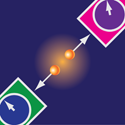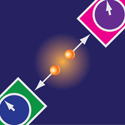A smoother quantum measurement
The precision of any measurement is fundamentally limited by the standard quantum limit. Often there are classical quantities related to the dynamical evolution of a quantum system one would like to measure, a process known as quantum parameter estimation. This kind of estimation is useful in delicate measurements ranging from gravitational wave detection to quantum computation. Recently, Tsang [1] considered the case of quantum estimation for dynamical systems and proposed a method called quantum smoothing that combines past observations with “future” measurements (that is, a signal is inferred from measurements both before and after a chosen point in time).
As reported in Physical Review Letters, Trevor Wheatley at the University of New South Wales in Canberra, Australia, and co-workers in Australia, Japan, and Canada now have experimentally tested these ideas by considering the problem of estimating the phase of a continuous optical field in the presence of classical noise. The authors use optical modulators to prepare a laser beam in a known state with a predetermined noise signature and then apply an adaptive measurement technique to estimate the optical phase. By including data obtained after time with data collected before along with Tsang’s theory, the researchers were able to estimate the phase at with a mean-square error more than a factor of smaller than the standard quantum limit. – David Voss
[1] M. Tsang, Phys. Rev. Lett. 102, 250403 (2009).





